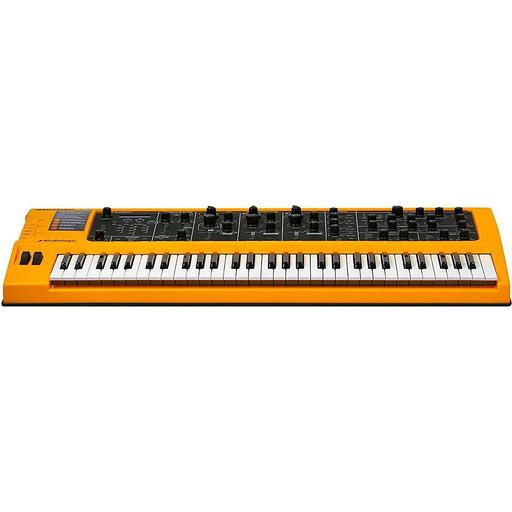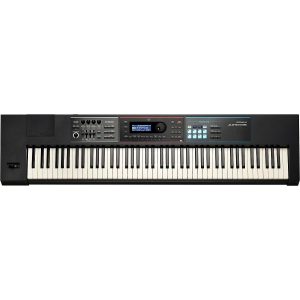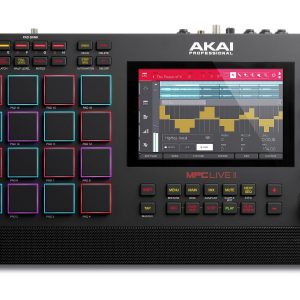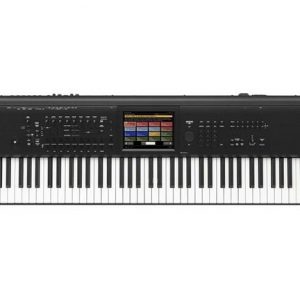Description
Studiologic Sledge 2.0 Synthesizer: A Synth-Powerhouse with a Vintage Touch
Synthesizers have become a staple of modern music production, allowing musicians and producers to create complex and unique sounds that were once impossible. Among the vast array of synths available today, the Studiologic Sledge 2.0 Synthesizer stands out as a synth-powerhouse with a vintage touch.
The Sledge 2.0 is an upgrade to the original Sledge synthesizer that was released in 2012. Studiologic has done an impressive job in refining its synthesizer by making it more versatile, user-friendly, and tonally rich. In this article, we will take a closer look at this synth and explore its features and capabilities.
Design and Build
The Sledge 2.0 synthesizer has a sturdy build, similar to its predecessor. The front panel is made of metal, which feels durable and gives it a high-end appearance. The synth has a 61-key keyboard, which gives it the advantage of having more keys than many of its competitors.
The control panel is well-organized, with all the knobs and buttons easily accessible. The display screen, which is located centrally, provides clear information about the sound you’re creating. It is also readable from any angle, which is helpful on stage when you need to make quick adjustments.
Sound Engine
Where the Sledge 2.0 shines brightest is its sound engine. It features three oscillators that each have their own waveform (sawtooth, pulse, triangle, sine) and 66 wavetables. The wavetables consist of 219 different waveforms, which can be combined to create complex and unique sounds.
There are several filters available on the Sledge 2.0, including the classic Moog ladder filter, Sledge smooth filter, and a comb filter. The Moog filter is well suited for creating warm and fat analog sounds, while the Sledge smooth filter is ideal for creating smoother, more natural tones. Additionally, the comb filter provides a unique resonant sound that is perfect for creating metallic, percussive sounds.
Effects and Arpeggiator
The Sledge 2.0’s effects section includes five effects: delay, reverb, chorus, phaser, and flanger. Each effect provides a range of parameters that allow musicians to create nuanced and complex sounds. The reverb has seven different algorithms, and the chorus and phaser provide various modulation speeds.
The arpeggiator of the Sledge 2.0 is another feature that stands out. It has eight different patterns and can be used in combination with the sequencer to create complex and rhythmic sounds. The sequencer, which has a maximum of 128 steps, is easy to use and can be used to store up to 16 different sequences.
Conclusion
The Studiologic Sledge 2.0 Synthesizer is an impressive synth with an array of features that make it a versatile and powerful tool for musicians and producers. The combination of vintage tonality and modern sound production makes the Sledge 2.0 an excellent choice for those looking for a professional-grade synthesizer. Though it is not the cheapest synth on the market, the quality of the sound and the build justifies its price tag, making the Sledge 2.0 a worthwhile investment for both studio and live performances.
Studiologic Sledge 2.0 properties
| Product name | Studiologic Sledge 2.0 |
| Brand | Studiologic |
| Type | Synthesizers |
| Rotary Controls | Yes |
| Colour | Black, Yellow |








Kimberly –
Hello, everyone. I’m just standing here thinking about the recent verdict in the case of a teenager who murdered a schoolgirl outside a shopping center. It’s just heartbreaking to think that such senseless violence can occur.
A jury has rejected the defense’s claim of diminished responsibility for the 17-year-old Hassan Sentamu, who stabbed Elianne Andam to death last year. I mean, what can you say about something like this? It’s just a tragic loss of life.
Now, let me talk about something completely different – Synthesizers. You know, those electronic keyboards that musicians use to create music. I’m not going to mention any specific brand, but there is one model that I think could be really useful for a waitress living in Kansas City.
This Synthesizer has a lot of features that would be great for a musician who needs to practice on the go. It’s lightweight, easy to use, and has a built-in sequencer that allows you to create complex patterns and sounds. Plus, it’s affordable and comes with a variety of sounds and effects.
But what does this have to do with the recent verdict? Well, I think that music can be a great way for people to express themselves and process their emotions after going through traumatic events like what happened in this case. And maybe, just maybe, something like this Synthesizer could help people cope with their feelings and find some sense of peace.
As for the economy situation in Kansas City, it’s not looking too good right now. The city is still recovering from the economic downturn a few years ago, and there are a lot of businesses that are struggling to stay afloat. But, you know, I think that this Synthesizer could be a great investment for someone who is interested in music.
I mean, let’s face it – music is not just a hobby anymore. It’s a business. And with the rise of online platforms like YouTube and SoundCloud, there are more opportunities than ever for musicians to share their music with the world. So, if you’re thinking about buying something like this Synthesizer, I would say go for it.
But, be warned – it’s not going to make you rich overnight. Music is a lot of work, and it takes a lot of dedication and perseverance to succeed. But, if you’re passionate about music, then it might just be worth it.
In fact, I think that this Synthesizer could be a great investment for anyone who is interested in music. It’s affordable, easy to use, and comes with a variety of sounds and effects. And, let’s be real – it’s not like you’re going to find anything better out there.
But, what about the economy situation in Kansas City? I mean, it’s still pretty tough out there. The unemployment rate is high, and a lot of people are struggling to make ends meet. But, maybe something like this Synthesizer could help. Maybe it could be a way for people to express themselves and find some sense of purpose.
I don’t know – I’m just throwing around ideas here. But, what do you think? Do you have any thoughts on the economy situation in Kansas City, or how music might be able to help?
And, as for today’s news… well, it’s just tragic, really. A teenager guilty of murdering a schoolgirl outside a shopping center. I mean, what can you say about something like this? It’s just senseless violence.
But, hey – let’s try to stay positive. Maybe something good will come out of all this. Maybe people will start to come together and support each other in ways that we never thought possible. And maybe, just maybe, something like this Synthesizer could be a part of it.